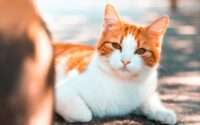How Long Do Cat Trees Last? Key Factors that Influence Their Longevity!
At BarkLikeMeow, we understand the essential role that cat trees play in keeping our feline friends happy and healthy. These multi-tiered structures provide a sense of adventure, exercise, and comfort for our cats. However, it’s crucial to know how long cat trees typically last to ensure our pets continue to benefit from them.
In this comprehensive guide, we’ll delve into the factors that influence the lifespan of cat trees and share tips on how to extend their longevity. Whether you’re a cat owner or a curious cat enthusiast, you’ll find valuable insights here to keep your cat tree standing tall and your feline friend content.
Understanding Cat Trees
What Is a Cat Tree?
A cat tree, also known as a cat condo or cat tower, is a specially designed structure for indoor cats. It’s a little piece of feline paradise that usually features platforms, perches, hiding spots, and scratching surfaces. Cat trees come in various shapes and sizes, catering to the unique needs and preferences of our furry companions.
Types of Cat Trees
- Traditional Cat Trees: These are the classic cat trees with multiple levels, often resembling a miniature tree with branches and platforms.
- Modular Cat Trees: Modular cat trees allow you to customize the layout and configuration, ensuring it fits perfectly in your space and suits your cat’s personality.
- Wall-Mounted Cat Trees: Ideal for smaller spaces, wall-mounted cat trees save floor space while providing vertical opportunities for climbing and lounging.
Materials Used in Cat Trees
The durability and longevity of a cat tree largely depend on the materials used in its construction. Common materials include:
- Wood: Sturdy wooden frames provide the foundation for cat trees and contribute to their stability.
- Carpet: Carpeted surfaces are inviting for scratching and provide a cozy resting place for your cat.
- Sisal Rope: Sisal rope-covered posts are perfect for satisfying your cat’s natural scratching instincts.
- Plush Fabric: Plush fabric coverings add comfort and warmth, making cat trees even more appealing to your pet.
The Role of Cat Trees in a Cat’s Life
Cat trees serve as multifunctional play centers for our feline companions. They offer several benefits:
- Exercise: Cat trees encourage climbing, jumping, and play, helping cats stay physically active and healthy.
- Scratching Outlet: The sisal rope or carpeted surfaces provide an appropriate place for cats to scratch, saving your furniture.
- Territory Marking: Cats like to perch up high, allowing them to observe their surroundings and establish their territory.
- Privacy and Comfort: Many cat trees include cozy hideaways or perches where cats can nap in peace.
Stay tuned as we dive deeper into the factors that influence how long your cat tree will last and how to ensure it provides years of enjoyment for your feline friend.
How Long Do Cat Trees Last?
A cat tree’s lifespan typically ranges from 5 to 10 years. Factors such as quality, usage, and maintenance play a significant role in determining how long it lasts.
Factors Affecting Cat Tree Lifespan
- Quality of Materials: When it comes to cat tree longevity, the quality of materials used is paramount. High-quality cat trees are built to withstand the test of time, while cheaper alternatives may deteriorate faster. Investing in a cat tree made from durable materials ensures it will remain a sturdy and safe haven for your cat.
- Construction Quality: The sturdiness of your cat tree is determined by its construction. Well-built cat trees feature secure joints, strong supports, and proper weight distribution. Avoid flimsy structures that may wobble or collapse over time, potentially causing harm to your pet.
- Cat’s Activity Level: Consider your cat’s activity level when selecting a cat tree. More active cats may put more strain on the tree, so opt for a robust design that can withstand their energetic antics.
- Number of Cats Using the Tree: If you have multiple cats, the wear and tear on the cat tree can be accelerated. Choose a cat tree that can accommodate all your feline friends comfortably and look for signs of overuse.
- Location and Placement: Where you place your cat tree matters. Avoid exposing it to direct sunlight, as UV rays can fade and weaken materials. Also, be mindful of humidity levels, as excessive moisture can lead to mold and rot.
- Maintenance and Cleaning: Regular cleaning and maintenance can significantly extend the life of your cat tree. Cats can leave behind dirt, fur, and the occasional accident. Cleaning these promptly and ensuring the cat tree stays free of stains and odors is crucial.
Environmental Factors
Environmental conditions play a role in cat tree longevity:
- Humidity: High humidity can cause wooden parts to swell and warp, while low humidity can lead to cracking and drying out of materials.
- Sunlight Exposure: Prolonged exposure to sunlight can cause fabric and wood to fade and weaken.
- Temperature: Extreme temperatures can affect the structural integrity of your cat tree, so avoid placing it in areas with rapid temperature fluctuations.
Signs of Cat Tree Wear and Tear
- Scratching and Claw Marks: Cats love to scratch, and your cat tree is the perfect outlet for this behavior. However, excessive scratching can wear down materials over time. Look for signs of wear on posts and surfaces.
- Loose or Unstable Parts: A wobbly cat tree is a safety hazard. Regularly inspect your cat tree for loose bolts, screws, or platforms that may need tightening or replacement.
- Stains and Odors: Accidents happen, and if not cleaned promptly, stains and odors can become embedded in the fabric or wood. These can be challenging to remove and may signify the need for a replacement.
- Torn or Frayed Fabric: Cats’ claws and teeth can damage fabric coverings. Torn or frayed fabric can make the cat tree less appealing and less comfortable for your pet.
- Fading and Discoloration: Over time, exposure to sunlight can cause fading and discoloration in fabric and wood. While this may not affect functionality, it can impact the aesthetics of the cat tree.
Understanding these signs of wear and tear is essential for assessing the condition of your cat tree and knowing when it’s time for maintenance or replacement. In the next section, we’ll explore how to prolong the lifespan of your cat tree and keep it in excellent condition for your cat’s enjoyment.
Extending the Lifespan of Your Cat Tree
Regular Cleaning and Maintenance
Just like any piece of furniture, cat trees require regular cleaning and maintenance to stay in top condition. Here are some essential maintenance tips:
- Vacuum and brush off cat hair regularly.
- Wipe down surfaces with pet-safe cleaning products.
- Inspect for loose parts and tighten them as needed.
- Replace worn-out or damaged fabric or sisal rope coverings.
Providing Alternative Scratching Outlets
To reduce wear and tear on your cat tree, provide alternative scratching options. Cat scratching posts and cardboard scratchers can divert your cat’s attention from the cat tree’s surfaces.
Rotating and Repositioning the Cat Tree
To distribute wear more evenly, periodically rotate and reposition your cat tree. This prevents your cat from favoring one side or platform over others.
Reinforcing Weak or Worn Parts
If you notice specific parts of your cat tree showing signs of wear, consider reinforcing them. Adding additional screws or brackets can help strengthen weak areas.
DIY Repairs and Replacements
Many minor issues with cat trees can be fixed with DIY solutions. Repairing or replacing damaged carpet or sisal rope is a cost-effective way to extend your cat tree’s lifespan.
When to Replace Your Cat Tree
- Safety Concerns: The safety of your cat should always be the top priority. If you notice significant structural issues, such as unstable platforms or wobbly posts that cannot be repaired, it’s time to replace the cat tree. A compromised cat tree can pose risks to your cat’s well-being.
- Behavioral Issues: Changes in your cat’s behavior may indicate that the cat tree is no longer meeting their needs. If your cat shows less interest in the tree, avoids it, or becomes anxious around it, it may be time for a replacement. Behavioral issues can often be resolved with a new and exciting cat tree.
- Cat’s Age and Changing Needs: As cats age, their activity levels and preferences may change. An older cat may not need or enjoy the same level of activity as a younger one. Consider your cat’s age and evolving needs when deciding whether to replace the cat tree with one that better suits their current lifestyle.
By following these tips and knowing when to replace your cat tree, you can ensure that your feline friend continues to have a safe and enjoyable place to play, scratch, and relax. In the next section, we’ll explore strategies for making informed choices when purchasing a cat tree, allowing you to maximize its lifespan from the very beginning.
Prolonging Cat Tree Lifespan Through Buying Strategies
- Investing in High-Quality Cat Trees: One of the most effective ways to extend the lifespan of your cat tree is to invest in a high-quality one from the start. Quality cat trees are often constructed with durable materials and sturdy craftsmanship. While they may come at a higher initial cost, they are more likely to provide lasting value and withstand the test of time.
- Reading Reviews and Doing Research: Before purchasing a cat tree, take the time to read reviews and do thorough research. Other cat owners can provide valuable insights into the durability and longevity of specific models and brands. Look for reviews that mention long-lasting cat trees that have stood the test of time.
- Evaluating Cost vs. Lifespan: Consider the long-term cost when evaluating cat trees. A cheaper cat tree may save you money upfront, but it may need frequent replacement, ultimately costing you more in the long run. Balance cost with expected lifespan to make a wise investment.
- Consideration for Multi-Cat Households: If you have multiple cats, it’s essential to choose a cat tree that can accommodate all of them comfortably. A larger, sturdier cat tree can withstand the increased activity and wear that come with multiple cats sharing the same play space.
Real-Life Case Studies
Stories of Cat Trees That Lasted a Decade
We reached out to cat owners in our community to gather real-life stories of cat trees that have endured the test of time. Here are a couple of heartwarming tales:
- Case Study 1: “Whiskers’ Tower of Adventure” Whiskers’ family invested in a high-quality cat tree made of solid wood and plush fabric. Over a decade later, the tree is still going strong. Whiskers, now a senior cat, still enjoys lounging on the top perch and occasionally indulges in a playful scratch.
- Case Study 2: “The Multi-Cat Marvel” In a household with three lively cats, a large, well-constructed cat tree has been a game-changer. The tree has endured the antics of the trio for seven years and counting, proving that the initial investment was well worth it.
Comparing Short-Lived vs. Long-Lasting Cat Trees
To highlight the importance of investing in quality, we also looked at some short-lived cat tree experiences:
- Case Study 3: “The Bargain Tree” A cat owner opted for a budget-friendly cat tree, hoping to save money. However, within just a year, the tree started to wobble and show signs of wear. Ultimately, they had to replace it, realizing that the initial savings were outweighed by the need for frequent replacements.
- Case Study 4: “Upgrading to Last” Another cat owner decided to invest in a high-quality cat tree after their previous cheaper one quickly deteriorated. The new cat tree has lasted five years and still looks and functions as if it were brand new, proving that quality pays off in the long run.
These real-life case studies underscore the importance of making informed choices when selecting a cat tree for your beloved feline friend. By investing in quality and considering the needs of your cat, you can ensure that your cat tree becomes a lasting and cherished part of your pet’s life.
Conclusion
In this comprehensive guide, we’ve explored the fascinating world of cat trees and their importance in enriching the lives of our beloved feline companions. Understanding the factors that affect cat tree longevity is essential for ensuring that your cat continues to enjoy their playtime, exercise, and relaxation.
By investing in high-quality cat trees, practicing regular maintenance, and considering the needs of your cat, you can maximize the lifespan of this essential piece of furniture. Real-life case studies have shown us that the initial investment in quality cat trees pays off in years of enjoyment for both you and your cat.
As responsible pet owners, it’s our duty to provide the best possible environment for our feline friends. With the knowledge gained from this guide, you’re well-equipped to make informed decisions about your cat tree, ultimately contributing to a long and happy life for your cherished pet.
Thank you for joining us on this journey to discover how to make cat trees last and for your dedication to the well-being of your furry family members. Here’s to many more years of playful adventures and cozy naps on your cat tree!
Frequently Asked Questions
Can I Repair My Cat Tree?
Yes, many minor issues with cat trees can be repaired. Loose screws can be tightened, and damaged fabric or sisal rope can be replaced. DIY repair kits are often available for these purposes.
What Can I Do If My Cat Tree Is Irreparable?
If your cat tree is beyond repair or poses safety risks, it’s best to replace it. Look for a new cat tree that meets your cat’s needs and is built with durability in mind.
How Do I Choose the Right Cat Tree for My Cat?
Consider your cat’s activity level, size, and preferences when choosing a cat tree. Opt for one that offers enough space, platforms, and scratching surfaces to keep your cat engaged.
Are DIY Cat Trees More Durable?
DIY cat trees can be durable if constructed well, but the quality of materials and craftsmanship is crucial. Ensure that any DIY cat tree you build is sturdy and safe for your pet.
Can I Make My Cat Tree Last Longer?
Yes, you can extend the lifespan of your cat tree through regular maintenance, cleaning, and proper placement. Providing alternative scratching outlets and reinforcing weak parts can also help.
How Can I Prevent my Cat Tree from Wobbling?
To prevent wobbling, ensure that all components of the cat tree are securely fastened. Tighten screws and bolts regularly. If wobbling persists, consider placing the cat tree on a level surface or against a wall for added stability.
What Should I Do If My Cat Stops Using the Cat Tree?
If your cat loses interest in the cat tree, try repositioning it or adding enticing toys and treats to encourage exploration. Cats’ preferences can change, so experiment to make the cat tree more appealing.
Is It Necessary to Replace the Entire Cat Tree if Only a Part Is Damaged?
No, you don’t always have to replace the entire cat tree if only a part is damaged. You can contact the manufacturer or search for replacement parts, such as scratching posts or fabric coverings, to repair and prolong the life of your cat tree.
Can I Build My Own Cat Tree?
Yes, building your own cat tree is a viable option if you have the skills and tools. DIY cat trees can be customized to your cat’s preferences and constructed with durable materials. Just ensure it’s safe, stable, and free of any hazards.
What Are the Best Practices for Cleaning a Cat Tree?
Cleaning your cat tree regularly is essential. Use pet-safe cleaning products to wipe down surfaces and remove cat hair. Vacuum fabric-covered areas and spot-clean stains promptly to prevent odors. Be sure to follow the manufacturer’s cleaning recommendations to maintain its integrity.





